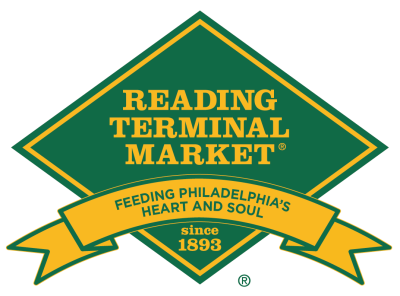For over 129 years, the Reading Terminal Market has provided a unique shopping and dining experience. Explore the Market’s rich history from 1893 to today!
Market Timeline
Reading Terminal Market celebrated its 130th year of operation
The streetscape outside the Market was enhanced to create a curbless “festival street” aimed at increasing public use of the 1100 block of Filbert St.
Reading Terminal Market operated as an essential business during the height of the COVID-19 pandemic ensuring Philadelphians had continued access to fresh, affordable food.
The Market Celebrates its 125th Anniversary on February 22nd.
The Reading Terminal Market celebrated 120 years of bringing fresh and local food to Philadelphia.
The Reading Terminal Market was 100% occupied, a result of growth in downtown residential population and tourism.
Non-profit Reading Terminal Market Corporation created to manage the market.
The adjacent Pennsylvania Convention Center opened and brought new customers to the market.
The Food Trust was founded as a program of the Reading Terminal Market
Pennsylvania Convention Center bought the Reading Terminal Market.
Supporters of the market organized The Reading Terminal Market Preservation Fund to ensure that the market retained its character as the convention center project developed.
The new Market East Station with rail and subway services connecting all major transportation lines opened underneath the market.
The last train left the Reading Terminal.
The market was 60% occupied and had become a center for charitable and seasonable food events and impromptu piano concerts.
The Reading Company emerged from bankruptcy, bought out the lease, and began to invest in the market.
Reading Terminal Market was only 20% occupied.
The Reading Company leased the Market to a real estate speculator 15 years. He raised rents driving out 30 of the 56 remaining merchants.
1970-1980: Preservationists who wanted to save the market battled with those who wanted to demolish it to advance the East Market Redevelopment plan
Reading Company declared bankruptcy and no longer invested in the upkeep of the market.
Informal markets formed around Front and High (Market) Streets near where farmers and fisherman brought their goods from southern New Jersey.
1950 – 1960 New local and federal regulations intended to improve safety of the food supply increased merchants’ cost of doing business.
Rationing during World War II brought episodic meat and dairy shortages to the nation
The market had 400 phone lines to take call-in orders.
Reading Terminal Market Merchants’ Association celebrated its fourth year in with the Third Food Show and Home -Progress Exposition with 140 exhibitors and 60,000 attendees. The Harry Taylor orchestra provided music throughout the nine day festival.
The Reading Company invested in new doorways and six refrigerated show windows along Twelfth Street.
Merchants organized the Reading Terminal Market Merchants’ Association to stem the loss of business from the City’s new parking regulations and the downturn in the economy. Merchants offered customers free nearby parking.
Reading Terminal Market advertised itself as the “Source of Main Food Supply of Philadelphia and Adjacent Territory” with 250 specialized dealers and 100 farmers occupying the stalls
Train service began at the new Reading Terminal.
The Reading Terminal Market opened for business. Merchants at the Butchers and Farmers’ Market and the Franklin Market moved into the new Reading Terminal Market.
Construction began on the Reading Terminal after the Company agreed to build a market underneath the new railroad station.
The Philadelphia and Reading Railroad Company consolidated its four Philadelphia terminals to build one large terminal in downtown Philadelphia. The Company purchased the 1110 block of Market Street.
The indoor Butchers’ and Farmers’ Market located in the 1100 block of Market Street opened for business. The indoor Franklin Market was established on 10th Street south of Market Street, but by 1885 had relocated next to the Butchers’ and Farmers’ Market.
Select and Common Councils of the City of Philadelphia directed the Commissioner of Markets to remove the outdoor market structures located on east Market Street and those located west of Broad Street.
Market Street had nine market houses that stretched from Water to Eighth Street and two markets west of Broad Street between Fifteenth and Seventeenth Streets
City ordinance changed the name of High Street to Market Street.
City Commissioners voted to demolish the 1709 market house to make way for new market houses made of cast iron.
The Columbia-Philadelphia Railroad began laying streetcar tracks on High Street. Streetcars were not permitted to run on market days.
City ordinance approved the rebuilding of the 1720s Jersey Market House on Market Street between Front and Second Streets.
Ordinance passed for building a fish market on High Street east of Water Street
Market sheds or shambles lined High Street from Second to Sixth Street
North Second Street Market at Second and Coates (later Fairmount) opened
New Market at Second and Pine Streets opened. The market house was added in 1804.
On market days, Wednesday and Saturdays, iron chains were put up at sunrise to protect shoppers from the carts and carriages
First permanent head house was built in the middle of Second and High Streets. Known as “Towne Hall” the building served as Pennsylvania’s capitol until 1735.
Local government agreed to have a formal market with a market head house located where Second Street crossed High Street.
Informal markets formed around Front and High (Market) Streets near where farmers and fisherman brought their goods from southern New Jersey.

